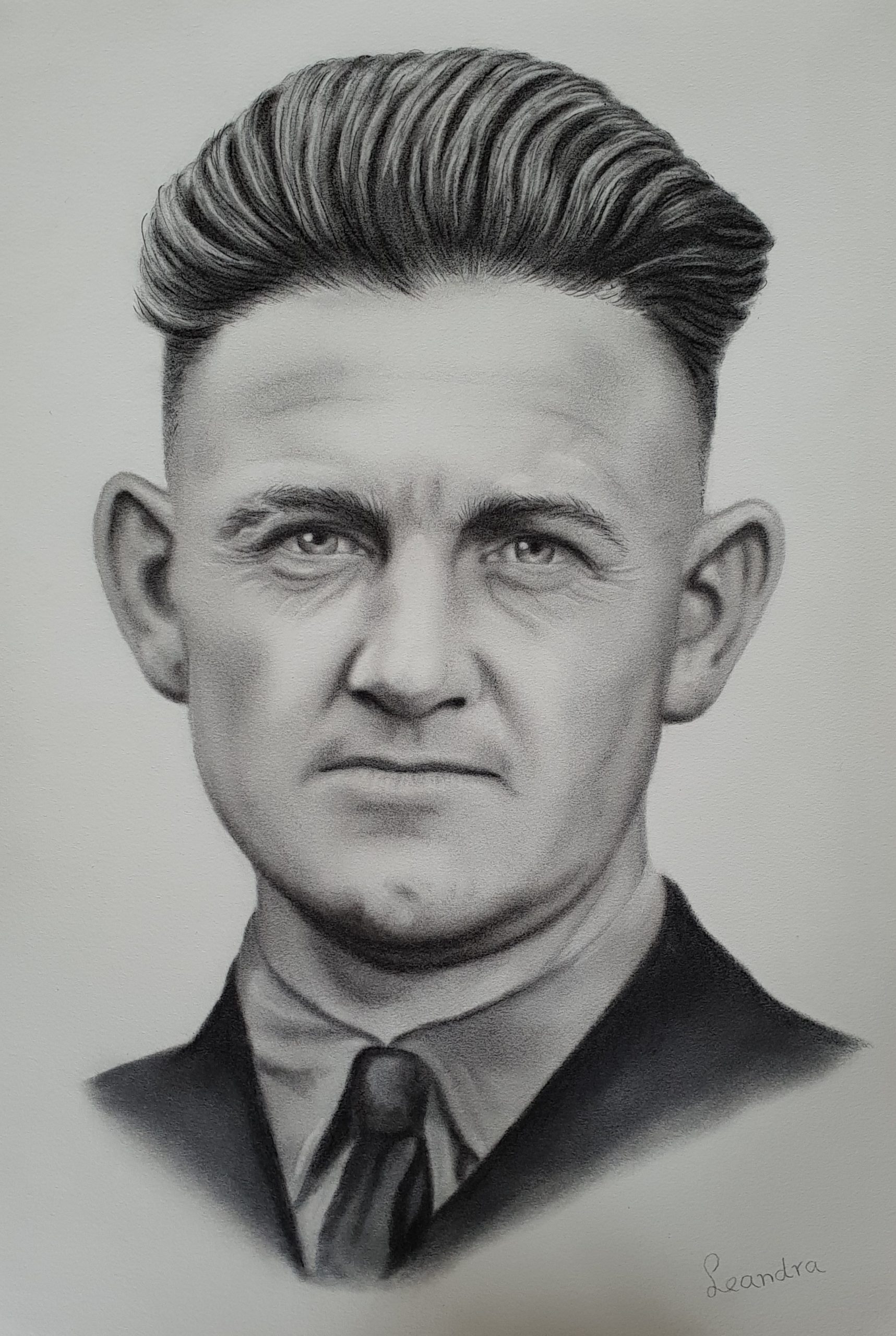Franz Hossler

SS-Obersturmführer Franz Hössler was born on 4 February 1906 in Oberdorf, in the Schwabenland of the German Empire. He was the son of a foreman and he quit school early to become a photographer. Later he was employed as a warehouse worker, but was unemployed during the Great Depression of the 1930’s. He joined the Nazi Party and the SS in early November 1932.
During his time in the SS, Hössler rose to the rank of SS-Obersturmführer and became a reserve officer in the Waffen-SS. After the establishment of the Dachau concentration camp in July 1933, he became the first member of the guard staff and worked later as a cook. He served at Dachau until after the outbreak of World War II.
In June 1940, Hössler was transferred to the newly opened Auschwitz I concentration camp as it received the first mass transports. He managed the camp kitchens and was occasionally used as a subcamp supervisor. He then became a Work Service Leader at the camp in early 1941. On 28 July 1941 Hössler accompanied a shipment of 575 selected Auschwitz I inmates to the euthanasia center at Sonnenstein Castle, where they were murdered as part of the Action 14f13 program. In June 1942, Hössler, together with Otto Moll and Hans Aumeier, participated in killing 168 survivors of a failed uprising in the punishment section of Auschwitz I.
On 12 October 1942, when Hössler worked in the old crematorium at the main camp Auschwitz I, SS camp doctor Johann Kremer later described an incident where approximately 1,600 Dutchmen were gassed. The Action was led by Hössler, where he tried to drive the whole group into a single bunker. This he achieved up to the last man who could not be crammed further into the bunker. Hössler shot this man with a revolver.
After Auschwitz-Birkenau was formally expanded into an extermination camp in 1942, Hössler took on various commands there. From September to November 1942, a brigade composed of prisoners called Sonderkommando Hössler exhumed 107,000 corpses from mass graves around Auschwitz I in order to burn them in the new Auschwitz II crematoria. The prisoners of the Sonderkommando were then almost invariably murdered after the action. To conduct this disposal, Hössler along with Rudolf Höss and Walter Dejaco, had previously visited the Chelmno extermination camp on 16 September 1942 to observe tests conducted by Paul Blobel.
By the middle of 1943, Hössler became involved in recruiting so-called “Aryan” prison women, with the prospect of better food and care, for a newly opened camp brothel at the Auschwitz I main camp. He was then promoted to the senior role of Schutzhaftlagerführer at the Auschwitz-Birkenau women’s camp in August 1943, which he directed together with Oberaufseherin Maria Mandel. In this role he participated in selections and gassings.
Filip Müller, one of the very few Sonderkommando members who survived Auschwitz, paraphrased Hössler’s speech given to trick a group of Greek Jews in the undressing room at the portals of the gas chambers. “On behalf of the camp administration I bid you welcome. This is not a holiday resort but a labor camp. Just as our soldiers risk their lives at the front to gain victory for the Third Reich, you will have to work here for the welfare of a new Europe. How you tackle this task is entirely up to you. The chance is there for every one of you. We shall look after your health, and we shall also offer you well-paid work. After the war we shall assess everyone according to his merits and treat him accordingly. Now, would you please all get undressed. Hang your clothes on the hooks we have provided and please remember your number of the hook. When you’ve had your bath there will be a bowl of soup and coffee or tea for all. Oh yes, before I forget, after your bath, please have ready your certificates, diplomas, school reports and any other documents so that we can employ everybody according to his or her training and ability. Would diabetics who are not allowed sugar report to staff on duty after their baths”. After this speech the whole group of Greek Jews were gassed.
Hössler was married and had three children, two daughters with an age difference of two years and the youngest, a son, with an age difference of four years. Hössler had Arthur Rablin perform personal services for him, and so Rablin frequently came to Hössler’s house. Hössler’s wife gave him food and an occasional glass of liqueur. She repeatedly asked him with a worried expression about her husband’s reputation among the inmates. On one occasion, when Rablin was taking Hössler’s children for a walk, they passed an inmate detail. Evidently the children had talked at home about the way the inmates were treated at that workplace because Frau Hössler reproached Rablin for not having shielded the children from that impression and asked him to avoid making them eyewitness of such mistreatment in the future. He said that he could read a certain shame in her eyes.
Some poles who were interned in Auschwitz from the beginning and hence had a better basis for comparisons than others have called Franz Hössler the best Auschwitz SS camp leader. Before the British military court to which Hössler had to answer after the end of the war, he declared that he had improvised a great deal in the women’s camp, which was in a catastrophic condition even by Auschwitz standards: “Since this construction was not part of the official plan, as the SS women’s camp leader I built by taking the material from other construction sites with the help of capos and other inmate functionaries and smuggling it into my camp.” A former block elder, Anna Palarczyk, confirmed this defence when she said that Hössler was a stove fitter by trade and could not stand it if something did not work. It was characteristic of him that he made sure the stoves in the barracks were in order.
Alica Jakubović, who was deported from Slovakia, emphasizes that it was possible to speak with Hössler, something that was generally impossible with SS leaders. She said he was not so bad as the others. Though she admits that he made many promises but often forgot to keep his word. At a selection in March or April 1944, Hössler said that enough Slovak women had already been selected, and so they were exempted at that time.
An episode described by Judith Sternberg-Newman corroborates Jakubović’s characterization of Hössler. One day a Jewish woman named Frieda became the victim of a selection even though she did not yet look like a Muselmann. In her despair she begged SS camp leader Franz Hössler for her life. He replied that he could not help her and that it would make no difference to her whether she died sooner or later. In her mortal fear Frieda continued to implore him, assured him that she was willing to work, and emphasized that her husband had served at the front in World War I. Hössler now asked her where she was from, and she replied that she was from Osnabrück. At length he promised that he would save her. However, when the selected women were loaded on trucks, Frieda also had to board one; evidently Hössler had forgotten his promise. When the trucks from the women’s camp drove by the SS camp leader, Frieda cried out his name as loudly as she could. This attracted Hössler’s attention and he asked her if she was the woman from Osnabrück. When she answered in the affirmative, he took her out of the vehicle. She never found out what Hössler associated with Osnabrück.
Eva Landstofova-Neumanova has described a similar incident. At a selection in the inmate infirmary, two healthy nurses were put on the list of those to be gassed. Bozena Teichnerova, the block elder, was bold enough to ask Hössler to help those two women. This was an extremely inopportune moment because Hössler had just applied his boots to the necks of a few women who were kneeling before him, begging for their lives. Nevertheless he granted the request of the courages block elder. This happened in the middle of 1943.
Krystyna Zywulska reports that Hössler took a liking to a five-year-old Russian boy and always asked about him when he visited the Russian block, While other children shyly hid from the SS, Wolodja ran up to Hössler right away, called him “Uncle,” and asked him how he was doing. This is what attracted Hössler’s attention; and when Wolodja died, he seemed shaken.
Witnesses at the first Auschwitz trial in Vienna who had been able to observe Hössler closely, because they had greater freedom of movement as capos, unanimously testified that Hössler had displayed great zeal in supervising the construction of the extermination facilities. It was probably due to this initiative that he was promoted to the position of SS camp leader with unusual rapidity. Tadeusz Paczula described Hössler as a man who changed completely when he had advanced to the rank of a führer. “Hössler made in the beginning the worst impression, nobody was worse than he. But as a führer he was quite different; for us inmates he was really the best SS camp leader.”, said Paczula.
For a short time between 15 March to 15 May 1944, Hössler was also camp commander of the Neckarelz concentration camp in Mosbach, Germany, a subcamp of the larger Natzweiler-Struthof camp complex in occupied France. Following the Allied invasion of France in June 1944, he returned to the Auschwitz main camp where he was Protective Custody Camp Leader until its final evacuation in January 1945.
In January 1945, as the Red Army overran German positions on the Eastern Front, the SS personnel at Auschwitz evacuated to the Mittelbau-Dora concentration camp. Auschwitz commander Richard Baer took over the Dora portion of the complex and Hössler was again made a Protective Custody Camp Leader. On 5 April 1945, as American 3rd Armored Division closed in on Mittelbau-Dora, Hössler led a forced evacuation of prisoners to the railhead for transfer to the still-functioning Bergen-Belsen concentration camp. The prisoners were then led on a death march for the last stage of their journey.
On 8 April 1945, Hössler arrived with his transport at Bergen-Belsen and became deputy camp commander under Josef Kramer. There he directly shot prisoners until the liberation of the camp, crimes for which he would be eventually arrested and tried. On 15 April 1945, Hössler was found hiding among the prisoners in camouflaged clothing and was detained with the remaining SS staff by a unit of the British Army. The SS detainees were then forced to bury thousands of corpses lying around on the camp grounds in mass graves.
Hössler and 44 other camp staff were tried in the Belsen Trial by a British military court at Lüneburg. The trial lasted several weeks from September to November 1945. During the trial Anita Lasker testified that Hössler took part in selections for the gas chamber. In his defence Hössler’s stated during the trial: “Everyone in the camp knew about the gas chamber in Auschwitz, but I never took part in the sorting out of prisoners”. On 17 November 1945 Hössler was sentenced to death by hanging. The sentence was carried out by British hangman Albert Pierrepoint on 13 December 1945 at Hameln prison.
Sources: People in Auschwitz by Herman Langbein / Auschwitz Täter, Gehilfen, Opfer und was aus inhnen wurde by Ernst Klee / Wikipedia
